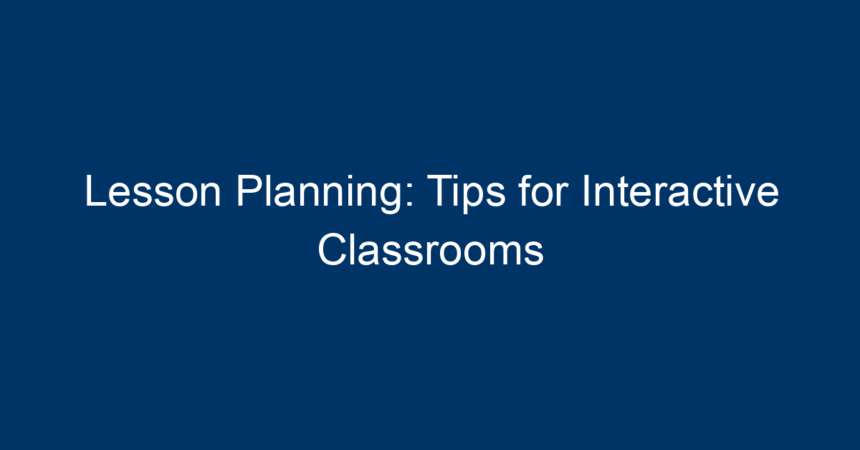In today’s rapidly evolving educational landscape, effective lesson planning is crucial for creating engaging and interactive classrooms. Teachers are not just disseminators of knowledge; they are facilitators who guide students through a journey of discovery. Interactive classrooms enhance student participation, foster critical thinking, and ultimately improve learning outcomes. This article provides practical tips for lesson planning that promotes interactivity, ensuring that every student’s voice is heard.
Understanding Interactive Learning
What is Interactive Learning?
Interactive learning is an approach that involves students actively participating in their learning process rather than passively receiving information. This method encourages collaboration, critical thinking, and creativity. By incorporating strategies that engage students, teachers can spark curiosity and a love for learning.
Benefits of an Interactive Classroom
- Enhanced Engagement: When students are involved in activities, they are more likely to stay focused and committed to the lesson.
- Improved Retention: Active participation helps students to process information more effectively, leading to better retention of knowledge.
- Fostering Skills: Interactivity encourages the development of communication, teamwork, and problem-solving skills.
- Catering to Diverse Learning Styles: An interactive environment accommodates various learning preferences, from auditory to kinesthetic learners.
Essential Tips for Effective Lesson Planning
1. Set Clear Objectives
Before diving into lesson planning, it is essential to establish clear and measurable objectives. What do you want your students to learn by the end of the lesson? Specific objectives guide the structure of your lesson and help assess student understanding.
Example: Instead of a vague goal like “understand fractions,” aim for “students will be able to solve basic fraction problems using visual aids.”
2. Incorporate Interactive Activities
Building interactivity into your lesson plan is key. Include various activities that require active participation. Here are some ideas:
- Group Discussions: Encourage students to share their thoughts with peers.
- Hands-on Projects: Allow students to create, build, or explore concepts physically.
- Role-playing: Use role-playing scenarios to help students practice skills in real-world contexts.
3. Use Technology Wisely
Integrating technology in lesson planning can enrich the interactive experience. Tools such as smartboards, online quizzes, and educational apps can make lessons more engaging. Platforms like Kahoot! and Quizizz turn assessments into fun games.
4. Foster Collaboration
Group work not only makes learning interactive but also cultivates essential social skills. When planning your lessons, consider including collaborative projects that promote teamwork.
- Peer Teaching: Pair students together to teach each other concepts, fostering a sense of responsibility for their learning.
- Group Problem Solving: Present students with real-world problems to solve as a team, encouraging critical thinking.
5. Encourage Questions
An interactive classroom thrives on curiosity. Ensure students know that it’s okay to ask questions. Create an environment where inquiries are welcomed, and facilitate discussions surrounding these questions.
- Questioning Techniques: Use open-ended questions to stimulate thought. Instead of simple yes/no questions, frame queries that require elaboration.
6. Utilize Real-World Connections
Connecting lesson content to real-life situations can spark interest. When students see the relevance of what they are learning, they become more engaged.
- Guest Speakers: Invite professionals related to the lesson topic to share their experiences. This can make learning more relatable and engaging.
7. Implement Diverse Assessment Strategies
Rather than relying solely on traditional tests, mix in formative assessments that allow you to gauge student understanding in real-time.
- Exit Tickets: Use brief reflections that students submit at the end of a class to assess their grasp of the material.
- Interactive Quizzes: Use tools like Google Forms or Socrative to conduct quizzes that provide instant feedback.
8. Reflection and Iteration
After each lesson, encourage students to reflect on their learning experiences. What did they enjoy? What did they find challenging? Use this feedback to iterate and improve future lesson planning.
Actionable Tip: Dedicate a few minutes at the end of each class for students to jot down their thoughts on what worked and what didn’t.
Crafting an Interactive Lesson Plan
Example Structure
An interactive lesson plan can be structured as follows:
- Objective: Clearly state the learning goals.
- Introduction: Begin with an engaging hook to draw students in (e.g., a related question, short video, or anecdote).
- Activities:
- Group discussions (15 minutes)
- Hands-on project (30 minutes)
- Technology integration (15 minutes for quizzes, games, etc.)
- Conclusion: Summarize the key points covered, and encourage questions or reflections.
- Assessment: Use accessible methods to evaluate understanding, such as exit tickets or self-assessments.
Conclusion: Enhancing Education Through Interactive Lesson Planning
Effective lesson planning is integral to cultivating an engaging and interactive classroom environment. By incorporating clear objectives, diverse activities, technology, and opportunities for collaboration, teachers can create a learning space where students feel empowered and excited about their education.
Interactive classrooms not only promote immediate learning but also equip students with skills that are crucial for their future. By continually reflecting on and adapting lesson plans based on student feedback and performance, educators can ensure that every lesson is not just a lecture but an engaging experience that inspires lifelong learning.
Incorporate these strategies into your lesson planning starting today, and watch as your classroom transforms into a vibrant hub of activity and learning. The journey to becoming an effective teacher begins with thoughtful, engaging lesson planning that prioritizes interactivity and student involvement.
Always remember, the goal of education stretches far beyond the acquisition of knowledge—it aims to spark a lifelong love for learning. So, embrace the power of interactive classrooms, and foster an environment where students thrive!




